iPad mini Review
by Anand Lal Shimpi & Vivek Gowri on November 20, 2012 6:10 PM ESTGPU Performance
Although most of the industry has done a great job in pushing CPU performance forward, Apple remains largely uncontested when it comes to mobile GPU performance. This isn't really due to some unsurmountable advantage, but rather a willingness to spend on SoC die area and incorporate big GPUs into its designs. The graphics IP all comes from Imagination Technologies, and although it's very well integrated by Apple, there are other SoC vendors that could push the envelope here - they simply have chosen not to.
Things are beginning to change as we saw with the introduction of Qualcomm's Adreno 320 based Snapdragon S4 Pro. NVIDIA's Wayne (Tegra 4?) SoC is expected to be much more competitive on this front as well.
As a result of many of the competing devices using slower GPUs, the mini looks a lot better in our GLBenchmark tests than its competitors.
We'll start out with the raw theoretical numbers beginning with fill rate:

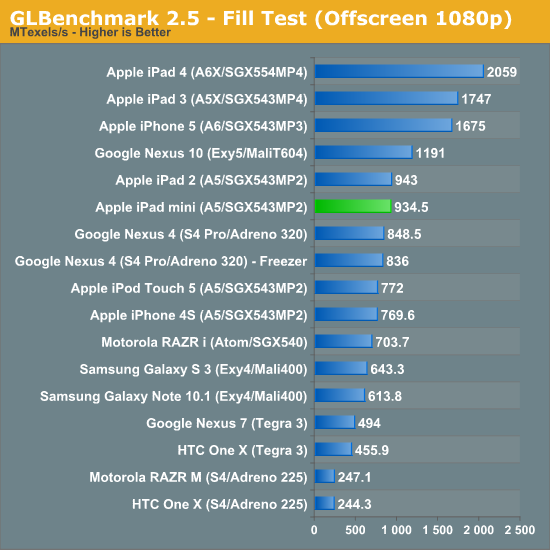
Other than the Nexus 10, the only devices that outperform the iPad mini here are other iPads or the iPhone 5. The mini's low native resolution will help ensure that gaming performance remains high for any currently available content.
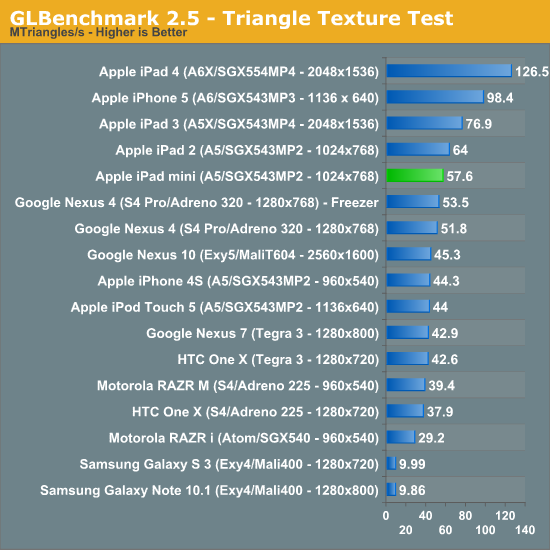

Triangle throughput looks very good here although the Tegra 3 based Nexus 7 is able to pull ahead on the offscreen test.
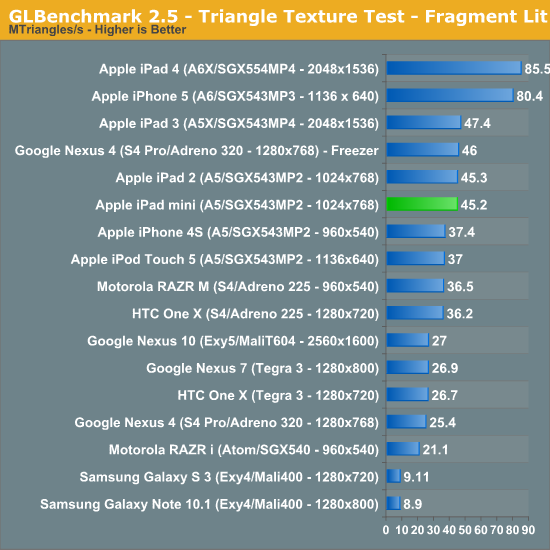
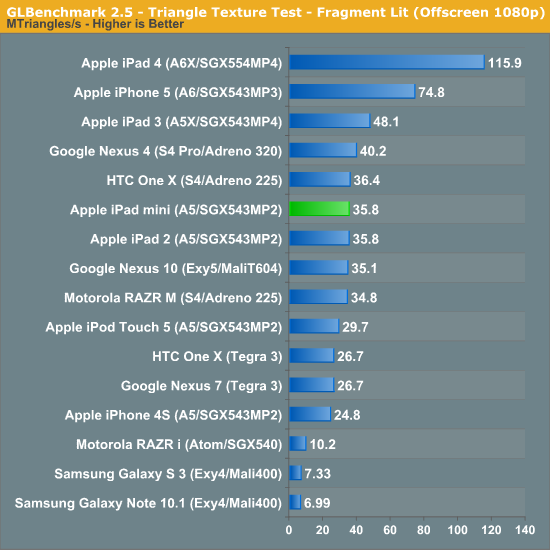
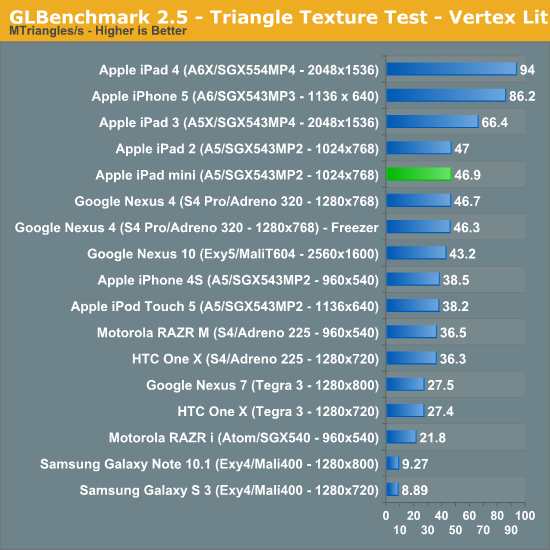
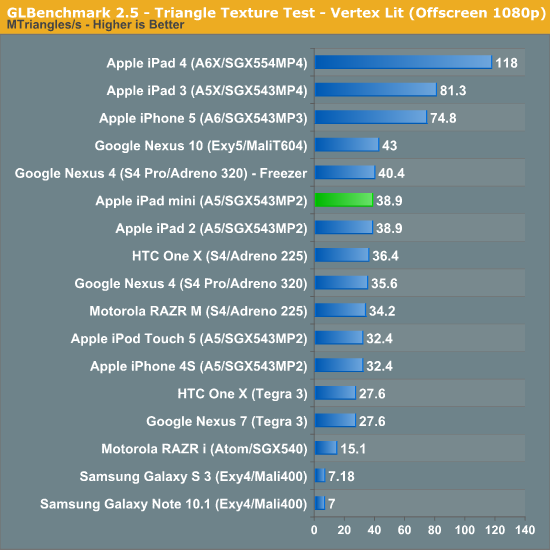
The mini continues to do quite well here vs the competition, although in the heavier triangle tests we see a clear difference between it and the A5X/A6/A6X based iOS devices.
With the synthetics out of the way, we can look at simulated game performance using the Egypt HD and Egypt Classic benchmarks. Remember the on-screen tests are run at native resolution with v-sync enabled, while the offscreen tests are run at 1080p with v-sync disabled for an architectural apples-to-apples comparison.
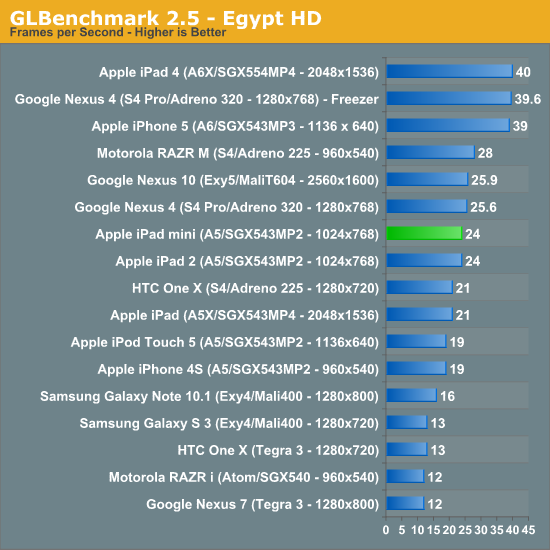
The mini does reasonably well running Egypt HD, which is a good indicator of future gaming performance on the device (perhaps ~2 years out for high end titles). The iPad 4's GPU does a good job of keeping up with its insane display resolution. The Nexus 7 doesn't fare nearly as well. Tegra 3 manages to run most current games just fine, looking forward though the GPU will probably not age too well.
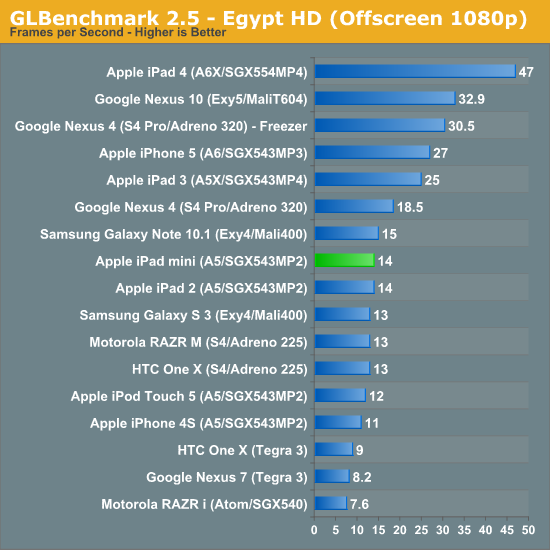
The offscreen tests show us what everything is really capable of given equal footing, and here the mini looks a lot more middle-of-the-road.
The Egypt Classic test is a much lighter workload, as a result most of these devices hit 60 fps at their native resolution:
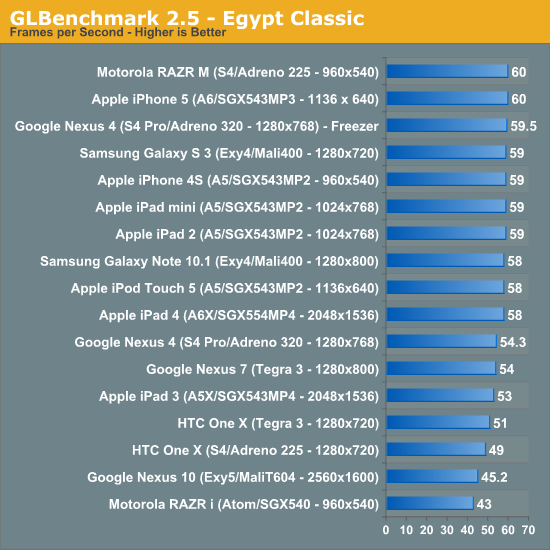
Although Egypt HD is a bit overkill for today's games, Classic undershoots by a good amount. The offscreen test however does provide some guidance as to whether or not these devices would be able to hit 30 fps on an appreciably heavier workload:

The mini does a good job here, although the iPad 3/4 and iPhone 5 are clearly quicker.
Overall the mini isn't a performance slouch. If you thought the iPad 2 was fast enough, the mini won't dissappoint. Its GPU remains very good and should be able to handle both present and upcoming iOS games. That being said, if Apple remains true to its typical cadence and gives next year's mini an A6 SoC I think that will end up being a much better match of price/performance.










140 Comments
View All Comments
MadMan007 - Tuesday, November 20, 2012 - link
Here's another display-related thing to fix: the charts for Brightness (black and white) and contrast don't include the Nexus 7 for some bizarre reason..hmm...but the later charts on the same page 4 do.Anand Lal Shimpi - Tuesday, November 20, 2012 - link
Fixed, thank you :)Take care,
Anand
ksherman - Tuesday, November 20, 2012 - link
While I understand where you're coming from, the reason the Nexus is zoomed in is because the Nexus "fakes" it's resolution in the web browser to about 603 so that responsive web pages render elements larger so they're easier to use on the Nexus 7. So the side by side photo is simply comparing the default view on load.In fact, this is actually somewhat of a negative for the iPad Mini on responsive sites because it means it's rendering pages designed for a much larger display.
Source: http://www.lukew.com/ff/entry.asp?1663
MadMan007 - Wednesday, November 21, 2012 - link
Now this would be something interesting to investigate and inform readers about. I didn't know about different devices presenting different resolutions and am not sure what the differences really mean.Galatian - Tuesday, November 20, 2012 - link
As a medical student I fast pretty fast in preordering the cellular white iPad mini here in Germany. It is the perfect size to fit into a white coats pocket. I will read a lot of books on it, so it was a hard decision between this and the 4th Gen iPad. But size does matter and eventually Retina will come to the mini line. For right now I just have to live with the resolution.Granseth - Tuesday, November 20, 2012 - link
This is a big issue for me with the Ipad 2, and it will be the same with Ipad mini. When I try to use the Ipad2 as a productive device I often lose information I write because the webpages and apps has to reload when the device gets out of memory and have to free something to load the next app/webpage. And this has become much worse as the Ipad has aged, so it's terrible that they are selling a new device with only 512MB of RAM.But hopefully people will use this smaller device as a consumption device, and not a productivity device.
ratte - Tuesday, November 20, 2012 - link
Excellent review as always, balanced and informative.It's a pity that Apple can't easily go to an intermediate resolution like 1600 x 1200, like Android can, but is stuck with the rezdoubling. For me the mini would have felt more futureproof if they had used an A6 with 1Gb memory. but then this is Apple....
MadMan007 - Tuesday, November 20, 2012 - link
Yeah, they need something obvious but AWESOME to make sure everyone buys a new one next year.Gaugamela - Tuesday, November 20, 2012 - link
Now it's easy to understand why Apple wanted to ban the Galaxy Tab 7.7. The iPad Mini is a rip-off of it. With a much worse display since the GT7.7 had a Super Amoled + display of superior resolution.Samsung was a year ahead of Apple and it still holds up great, if Samsung updated it to Jelly Bean.
I would like to see a new Galaxy Tab 7.7.
And the display is a disapointment. It makes it a no buy device instantly, it's 130$ more expensive than the Nexus 7 and offers a worse display. Anyone that picks the Mini should only do it by the form factor or preference by iOS.
ltcommanderdata - Tuesday, November 20, 2012 - link
The form factor is why I'm considering the iPad Mini over the Nexus 7. It has great build quality, is thinner, lighter, yet has battery life that is similar or better and has a screen that's a third larger. The Nexus 7's advantage in screen resolution in itself is not as important for me because the screen is smaller so showing more tiny content isn't useful. The lower pixel density is a concern for clarity. The CPU may be weaker, but the GPU is stronger which given good GPU acceleration for UI responsiveness is a reasonable exchange. $130 more maybe worth it if the better form factor makes the device more useable so that it sees more use.